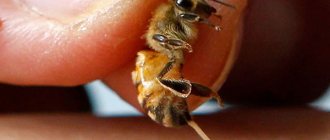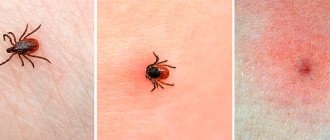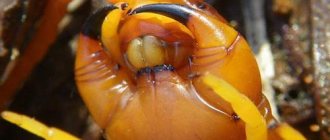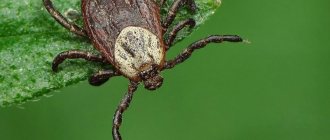How to tell if an insect has gotten into your ear
Before carrying out any manipulations at home, you should make sure that the cause of the unpleasant sensations is actually a living creature.
Here are the signs that indicate this:
- tickling inside the ear canal;
- buzzing and noise in the ear;
- pain and discomfort;
- congestion and hearing loss;
- dizziness;
- nausea and vomiting;
- swelling if an insect bites and causes an allergic reaction.
A visual examination can also confirm the presence of a foreign substance in the auricle, but not always. To do this, pull the edge of your ear to the side and up and shine it with a flashlight. The light can attract the midge, and it will fly out on its own.
Preventive measures
Can a person avoid getting midges in his ear and nose? Are there measures to prevent such problems?
Many species of midges have been found throughout the world. Some regions recommend wearing long sleeves with drawstrings to protect against them. They are called upon to protect your head with a mosquito net, which you definitely won’t be able to fly under.
Modern companies specializing in insect control produce special products in the form of creams and sprays that repel insects. The smell, felt only by insects, keeps them at a decent distance from humans.
In some cases, it is simply impossible to provide absolute protection against insects. You need to understand that the penetration of a midge into the ear or nose is a situation that does not threaten human life (at least in temperate and cold climates), so you should not panic.
The methods described above are extremely simple and applicable in everyday life. If you are unable to get the midge out with their help, you should still visit the hospital.
Can a midge caught in the ear or nose bite or lay eggs inside the human body?
Recently, Internet users have been concerned not only with questions about how to get an insect out of their ear or nose that has managed to fly there, but also about whether it will bite and lay eggs. These questions are inspired by information about how certain types of insects behave and reproduce in hot climates.
One should be afraid of bites if a person begins to panic, unsuccessfully trying to help himself with objects and methods that are not suitable for this task, which frightens the insect. That is why you must first drip a liquid into the ear, killing it or forcing it to crawl out. Many species of midges do not bite at all.
Midges that live in temperate and cold climates do not use the internal environment of the bodies of other animals to reproduce. Small creatures, for example, fruit flies, which more often than others find themselves in such situations, need rotting vegetables and fruits, and not a human body, to lay eggs.
When going to hot countries, it is worth asking about the types of insects living in a particular area and their characteristics.
What not to do
Under no circumstances should you try to remove an insect from your ear using a cotton swab, tweezers, sharp objects, etc. It makes sense to try with tweezers if it is visible to the naked eye, and then there is a risk that it will get scared and go deeper.
All other attempts to remove the insect from the ear using an object may result in it being pushed towards the eardrum. As a result, only a doctor can remove it.
Such manipulations can injure the ear canal and eardrum. Or it will be possible to remove part of the bug, but part will remain in the ear, causing inflammation.
What can't you do?
- Picking objects in the ear. Do not use a knitting needle, tweezers, toothpick, match or other sharp object that can damage the eardrum and other elements of the hearing organ to remove the insect;
- Use hazardous liquids for cleaning. Pouring alkali, brilliant green, acid, urine and any other specific substances into the ear canal is strictly contraindicated, as this will provoke the development of an inflammatory process;
- Do nothing. If the insect was not removed and died, then the risks of complications - suppuration, bacterial infection, and so on - increase.
Preparing for the procedure for removing an insect from the ear
Before you begin the extraction procedure, you should make sure that it is the insect that got into your ear. After all, pain, discomfort, rustling and extraneous sounds may indicate other hearing problems.
It is important to try to determine how deep the insect has climbed into the ear. The deeper it is, the more difficult it is to remove it yourself, and manipulations near the eardrum can lead to injury. In this case, you should not take risks, but consult a doctor immediately.
The person should take a comfortable position so that ear procedures are easy to carry out. The victim, and in the case of a child, his parents, must remain calm. Worried and panicking, a person acts abruptly, makes many unnecessary movements, and this only worsens the situation.
Protection methods
If you get into places where midges swarm, it is recommended to protect yourself not only with clothing covering the surface of the skin, but also with a hat. A mosquito net is ideal for these purposes - a special hat with a mosquito net that protects against attacks and bites of midges and mosquitoes.
Repellents are chemicals used to ward off insects. Such sprays and creams are good at repelling midges and other insects. Such means do not cause discomfort to a person. It is important to choose a product that repels midges.
Stay calm and try not to take rash actions. It is important to remember that the midges that live in our country are absolutely safe, and the fact that an insect appears in your ear does not in any way threaten human life. Don't panic.
When planning a trip to the countries of the southern hemisphere, it is worth studying what insects you should be wary of, how to protect yourself, and what actions to take if they get into the ear canal.
Be careful when choosing a method to get rid of an unwanted “guest” in your ear. Weigh the pros and cons, try to objectively assess your condition and think about the possible consequences of a rude or inept invasion, because your health is at stake.
The above symptoms often accompany an insect entering the ear canal, but they can also be symptoms of serious ear diseases. If you are not sure about the causes of pain and hearing impairment, do not self-medicate, consult a doctor immediately. After all, an object that has flown into the ear is a foreign body. A timely diagnosis of the disease and the prescription of the correct treatment will help to cope with the disease as soon as possible.
Insect removal
If an insect has not entered the ear deeply, it may well get out on its own. The main thing is to give him this opportunity. Sit comfortably, place a bright light source near your ear, do not touch the ear with your hands, do not bring objects - this can frighten the midge and provoke it to climb deeper.
You can try pulling your ear up and to the side, tilting your head in the right direction and jumping, shaking your head. This may be enough for deliverance.
If the method does not work and the midge remains inside, the first thing you need to do when removing it is to kill it. This alone will bring relief to the victim, because the main cause of nausea, dizziness and severe discomfort is the movement of the creature and the sounds it makes. This can be done using one of the traditional methods.
About the consequences of penetration
Tourists relaxing in the lap of nature especially often encounter similar situations. Such a case should not be ignored, since the consequences of the presence of a living creature in the ear can have very negative consequences.
- If a fly gets into the ear, it will try in every possible way to free itself from captivity, creating noise with its movement and irritating the walls of the ear canal. Such actions cause dizziness and pain in the head.
- Severe itching may also occur. Scratching the itchy area can damage the insect, resulting in deeper penetration of fragments of its body into the ear canal, which can cause serious illness. Therefore, you should never scratch an ear canal that has a fly, beetle, or other living creature inside it.
- Due to the fact that many flies feed on rotting organic waste and carrion, an insect caught in the ear opening can become a carrier of serious diseases.
Folk remedies for removing insects from the ear
There are folk methods on how to get rid of living creatures stuck in the ear canal. All of them involve rinsing the ear with different means:
- plain water;
- camphor oil;
- hydrogen peroxide.
Using a small syringe or pipette, you need to drip warm water into your ear, wait a couple of minutes, then tilt your head in the desired direction so that the liquid flows out on its own. The bug will flow out along with it.
Camphor oil acts more effectively as first aid, quickly killing midges and promoting better gliding. You should treat it in the same way as with ordinary water, slightly heating it beforehand. 3-5 drops of the product are enough.
If the oil does not work, you need to rinse your ear with hydrogen peroxide. The abundant foam it produces will effectively clear the passage of everything unnecessary. If all the measures taken are in vain, you need to go to the doctor. The doctor will act in a similar way. The difference is that he has tools that make it easy and painless to remove the “uninvited guest.”
What to do
Since the skin in the ear canal renews itself as quickly as nails, it is likely that the invading insect will be removed naturally. However, if there is discomfort and unpleasant sensations, you should take care to remove the parasite from the ear canal.
If a midge has flown into your ear, it is still not recommended to do something on your own. The best option is to contact a specialist who will not only remove the insect, but also treat the ear cavity to avoid the development of infections.
If this is not possible, it is worth providing the victim with qualified first aid.
The main measure of this is killing the insect. Please note: you should not carry out this procedure yourself.
Since the midge moves and buzzes, its presence in the ear causes noticeable discomfort:
- dizziness.
- Swelling of the affected area.
- Soreness.
- Nausea, vomiting.
- Short-term noticeable hearing loss.
- Headache.
To calm the uninvited guest, it is recommended to drop a few drops of alcohol tincture, mineral or any vegetable oil into the ear canal.
The insect will drown in the liquid, and the unpleasant symptoms will gradually disappear. In addition, the use of alcohol will provide additional disinfection.
What will you need?
You need to “drive” the insect out of the ear with the help of liquid. Boric alcohol, camphor oil or hydrogen peroxide are good for this purpose. Any of these liquids can solve this problem.
Preparing to remove an insect
If a fly has flown into the ear, but has only climbed to a shallow depth, it is able to get out of the ear canal on its own.
Some measures will help speed up this process:
- bright light, such as from a table lamp, aimed directly at the affected area. It is believed that it will attract a fly and it will get out.
- No external influence on the ear canal. Do not put fingers or foreign objects into your ear.
- The sun's rays, since some types of insects love heat very much.
Sometimes, to get rid of it, it is enough to shake your head, as if water gets into your ears, and the affected ear should be directed downward. If the indicated manipulations do not bring results, the insect will have to be removed mechanically.
Insect removal
Since it is necessary to remove the parasite from the ear cavity as soon as possible, the simplest and most conservative method is to move the earlobe, tilting it towards the floor. If the midge has not managed to get deep enough, it will fall out of the ear canal under the influence of gravity.
The essence of the process of removing the uninvited guest is to wash the ear canal. All manipulations should be carried out slowly and calmly, without making sudden movements. It is better to take a sitting or lying position with free access to the source of the problem.
At home, the following preparations are most effective for rinsing:
- Camphor oil.
The most popular way to get rid of midges that have flown inside the ear. The main ingredient should first be heated a little, then dropped into the affected ear (4-5 drops).
Wait a little for the oil to bring the desired result, and then let the product flow out, turning your head in the right direction. Usually this method is enough to get rid of midges, which simply flow out along with the oil.
- Hydrogen peroxide.
The effectiveness of this product is explained by the formation of a large amount of foam. It will not only push the flying living creatures out, but will cleanse the ear canal of excess wax.
If these drugs do not bring the desired result, you should use plain water:
- The pure liquid is heated to a warm state.
- The auricle is pulled back, thereby aligning the ear canal.
- Drop liquid into the affected ear using a pipette, a syringe without a needle, or a small syringe.
The principle of operation is similar to the method with oil.
A mandatory element of any of the above methods is a subsequent contact with a medical professional. If it was not possible to remove the insect from the ear on your own and with improvised means, the doctor will perform this procedure with a special device.
Recovery measures after removing an insect from the ear
After you have managed to remove the insect from your ear at home, you need to carefully examine the “culprit” of the incident. It is important to make sure that it is completely removed and no part of it remains inside.
The victim, especially if it is a child, needs to be provided with peace after the stress experienced and not engage in special stress. The work of the vestibular apparatus disrupted by the insect's interference will be restored quickly, but gradually, you need to wait and rest.
It is important to carefully monitor the well-being of the person who has an insect in the ear for several days. If inflammation begins, swelling appears in the ear, and the temperature rises, this means that there is still part of the bug left in the passage, or it has managed to bite.
If there is pain in the ear, hearing is impaired and is not restored, blood is released, this may indicate damage to the eardrum. In all these cases, you need to consult a doctor.
Methods for detecting insects in the ear
Probably every person at least once in his life has heard a story about how a fly flew right into the ear of his friend or close relative. Such situations can really happen to anyone and especially to young children who spend a lot of time outdoors.
Basically, ants, mosquitoes, flies, grasshoppers, and other small insects get into the human ear when people relax in the forest, walk in the park or in the garden of their own home on summer days.
In such a situation, many people panic. Women and small children are especially afraid of pests; the latter often cry when a tiny bug crawls into a child's ear.
First you need to calm down and try to determine whether the pest has really gotten inside the ear canal. The following signs will help you understand that there is an insect in your ear:
- Periodic itching, burning and a feeling of congestion in the hearing organ. Such symptoms provoke movements that the insect makes in the ear. It seems to a person that his hearing is decreasing, but this feeling arises against the background of constant noise from the movements of the legs and wings that the insect makes.
- Dizziness and partial loss of orientation. They can appear when the bug has climbed quite deep into the ear, or it is quite large in size.
- Allergic reactions. They appear as redness of the skin inside the ear, acute pain, swelling of the ear when bitten by a bee or wasp that has crawled into the ear. A similar reaction is also possible to the beetle’s saliva, which it secretes when it bites through human skin.
- Panic and fear. They arise against the background of psycho-emotional stress caused by an immediate desire to get a fly out of the ear. Such strong emotions can cause headaches, nausea and even a gag reflex.
Important! Particularly dangerous is the case if a wasp or bee has flown into your ear. Such insects can sting, which provokes the development of an allergic reaction in many people. Under this set of circumstances, the ear may become swollen, red and very painful.
The longer the pest is inside, the stronger the discomfort inside the hearing organ becomes. That is why it is so important to understand in a timely manner whether a beetle can sit in the ear. If this does happen, then you need to decide as soon as possible how to get the harmful insect out of the ear without harming the person.
Symptoms
So the symptoms show themselves as follows:
- Attacks of acute pain and unpleasant sensations reminiscent of tickling inside the ear.
- The patient feels congestion in the ear canal and a decrease in the level of hearing.
- Attacks of dizziness and mild nausea, and in particularly susceptible patients the gag reflex is a consequence of irritation of the nerve endings located inside the ear.
- If living creatures emit chemical or other biological, irritating compounds, swelling, necrosis of the dermis, and, less often, bleeding caused by bites are possible.
- Inflammation occurs very rarely - it is more likely a consequence of complications, as well as the manifestation of seizures from irritation of nerve endings.
You can notice the presence of a living creature in your ear by feeling it. The pest will try in every possible way to get out. Scratching the paws, moving, and moving cause discomfort, pain, and tinnitus. In most cases, a person begins to take action almost immediately. If an insect gets into the ear of a small child, complications develop.
How to identify a foreign body in a child’s ear?
Either try to extract it on your own, using folk remedies, which we will discuss later, or immediately visit an ENT doctor.
First aid
The order of first steps is as follows:
- At the very beginning, carry out a visual inspection with the help of an assistant - pull the auricle back and shine it with a flashlight so that you can clearly see what has gotten inside.
- If the foreign object is clearly visible, then extraction is carried out, otherwise, the help of a doctor is needed. If you do it incorrectly, you can injure your ear, eardrum, or an insect can bite if you actively press on it.
READERS RECOMMEND!
Say goodbye to pests FOREVER!... An environmentally friendly device that repels rodents and insects will help in the fight against rodents and insects...
First aid for a foreign body in the ear
- Skin damage and bleeding;
- Damage to the eardrum;
- Incomplete extraction (remains of the midge's body may begin to decompose and lead to infection);
- Pushing the insect further down the ear canal.
If a person has previously suffered damage to the eardrum, all procedures involving the use of water are contraindicated in order to avoid water getting into the middle ear. It is necessary to carefully study the situation before taking drastic measures.
What you definitely shouldn’t do if an insect gets into your ear
The main sign that an insect has entered the ear is the feeling of the presence of a foreign object in the hearing organ. Listen to yourself to see if a mosquito is buzzing in your ear. If the symptoms of the presence of an insect inside the ear are confirmed, you must not lose composure.
Rash actions can provoke a number of negative consequences, so it is important to get together and think through ways to remove a foreign body from the hearing organ.
Experts do not recommend performing the following actions so as not to harm your own health. What not to do:
- Try to pull out an insect that has flown into the ear using a match, ear stick, knitting needle, tweezers and a number of other improvised objects. In this way, you can injure the ear canal or introduce an infection inside the organ, which will lead to consequences, even hearing loss.
- Try to drip alcohol, kerosene, and other liquids inside, which, according to folk craftsmen, can lead to the death of a mosquito. It is possible that the insect will actually die, but instilling a number of liquids into the ear can cause irreparable harm to human health and reduce hearing acuity.
The further the beetle moves inside the hearing organ due to inept human manipulation, the more difficult it will be to get it. The ideal solution in this case would be a timely visit to a doctor, who, using sterile medical instruments, will remove the foreign body from the hearing organ in a matter of minutes.
Pest removal methods
If you removed a fly from your ear yourself or a doctor did it, you should take care of subsequent recovery and protect the auricle from possible infection:
- After the removal procedure, wipe the ear with an alcohol solution, clearing it of wax with an ear stick.
- Rinse your ear with warm water, always boiled.
Important! Although such manipulations are necessary, they can provoke poor coordination and attacks of dizziness. That’s why it’s so important to lie down for a while after the manipulations and not make sudden movements.
If insect particles remain in the ear, this can provoke the development of a focus of infection and inflammation of the ear canal. Therefore, when the first signs of infection appear - fever, purulent discharge and pain, you should consult a doctor.
What to do if a fly flies into your ear - Pest Control
When spending time outdoors, especially overnight in a tent, an insect may crawl into your ear. It could be an ant or a small bug. Sometimes some kind of midge flies in while walking. There are rare cases of small Prussians crawling into the ear canal when chemical persecution occurs in the apartment, and they seek shelter.
Unlike adults, young children will not be able to describe what happened, and it is important for parents not to ignore indirect factors: the baby’s hearing has become worse in one ear, restless behavior has appeared, the child is turning and shaking his head. Regardless of the age of the victim, it is important to know what to do in such a situation. Is it possible to pull out a fly or some kind of insect on your own? What means to use?
Let's keep calm
If there is an insect in your ear, you should try to calm down. The midge will try to look for a way out, and all its movements will be clearly audible to the victim. Proximity to the eardrum produces louder sounds. Dizziness and noise in the head begin. The first reaction is stress and a strong desire to do something.
The most terrible thoughts can “climb” into your head. There is a fear that the fly will get through the ear canal into the brain. Or the fear that the midge will get stuck in the sulfur and die, causing inflammation there. When a Prussian dog crawls into your ear, some people think that it can breed there.
The imagination of a person in a stressful situation has no limits, and gloomy thoughts can replace each other with great speed. We need to calm down. The structure of the ear includes three parts: inner, middle and outer. All important nerves and particles are located deep. The external meatus is separated from the middle ear by the eardrum.
An insect is unlikely to penetrate through it, due to the impenetrability of the organ. Consequently, a fly or other creature will only reach this barrier, and its position is comparable to falling into a narrow test tube. There is no reason to panic. The challenge is how to extract it from there.
What can you do?
If the hospital is far away, for example, it happened in the forest or at a campsite, since the situation is not critical and there is no serious threat to health, you can try to help yourself. A trivial but logical way is to shine a flashlight into your ear. Many insects are instinctively drawn to the light, and if it is still alive, it will be able to crawl out on its own.
The problem can be made worse by a large beetle that cannot turn around in a narrow passage. The next attempt to remove an insect lodged in the ear will involve a series of steps that will require the help of a second person:
- The victim must be placed on his side, with the problematic ear facing up.
- You can place white napkins or towels around the ear, which will absorb moisture and make it easier to notice the removed midge against their background.
- Liquid must be poured into the ear canal to kill the insect. You can use: boric alcohol, vodka, sunflower oil. It should be poured slowly using a syringe without a needle or a watering can with a narrow spout. A regular teapot for brewing tea will do.
- When the victim reports no movement in the ear, you need to rinse the passage with warm water. You must watch carefully so as not to miss the appearance of midges on the surface.
- When a fly or other creature is removed, it is necessary to examine it for integrity (head, wings, legs). This will help determine if the problem has been completely resolved. If necessary, washing can be repeated a couple of times.
If the problem does not resolve, it is important to contact a clinic rather than continue pouring fluids into the ear. Any ENT doctor will provide assistance.
He perfectly understands the structure of the passage, the location of the object, and has an arsenal of tools for extracting such things. It is worth making an appointment even if the outcome is successful.
This will ensure that the eardrum was not damaged during the process of removing the insect.
What not to do?
It is worth noting that only liquids can safely help in such a situation. The use of hard objects is strictly prohibited! Do not use: tweezers, cotton swabs, matches, hairpins, knitting needles or pencils. This will only push the midge deeper into the ear and make the situation worse.
Even after removing the midge, for some time it may seem that there is still someone in the ear. The crawling sensation and other similar feelings are false. After experiencing stress, the body still “moves away” from the foreign body and the nerve endings, being in an excited state, send incorrect impulses to the brain. It goes away in a couple of days.
Getting an insect in your ear is a real stress for anyone. But there is no danger to life and health here. The following tips will help you resolve the situation in a medically competent manner. A visit to the doctor is important to make sure that the problem is eliminated completely and without consequences.
Source:
What to do if an insect gets into your ear: first aid
With the onset of warm days, everyone tries to get out into nature to relax and improve their health after a grueling winter. But sometimes, instead of joy and a pleasant pastime, a person finds himself in an unpleasant situation due to the fact that a fly has flown into his ear.
Fly
At first glance, it would seem that the probability of such a case is zero, but it often happens that an otolaryngologist is asked for help with precisely this problem.
Can a fly fly into your ear?
The human ear is designed in such a way as to minimize the likelihood of various foreign objects, especially insects, getting there. But anything can happen in life, and sometimes it happens that during the flight of a fly, a human ear will be located on the trajectory of its flight.
In this case, it may happen that the insect gets directly into the ear hole. Out of fear and an incomprehensible situation, the fly, instead of getting out, will crawl into the ear canal even further, which will completely exclude its ability to get out on its own.
There are also often cases when a small midge gets into a person’s ear. Although it is smaller in size, it also cannot get out of the ear on its own. Therefore, for those who doubt whether a fly can fly into a person’s ear, it should be said that this is really so and if this happens, the person will not feel very comfortable.
How to get rid of midges that have gotten into your nose?
In addition to the ear, the midge can also get into the nose. This kind of problem is not often addressed to specialists. In order for such a small living creature to end up in your nose, you just need to walk down the street. Getting it is easier than it seems at first glance. In order to get rid of an insect in the nose on your own, an adult can try the following:
Structure of the nasal cavity
- Breathe deeply, exhaling forcefully through your nose (this method will only work if it is close enough);
- Rinse your nose and nasopharynx with warm salted water (it is advisable to use sea salt for rinsing);
- Blow your nose.
If such a problem happens to a child, you should try to pull out the midge with an enema or drip your nose with baby nasal drops. There are also special devices that suck out pus from children's noses, which can also be used to solve the problem.
If you still cannot cope with the problem on your own, you should seek qualified help from an otolaryngologist who can eliminate it without harming the patient’s health.











